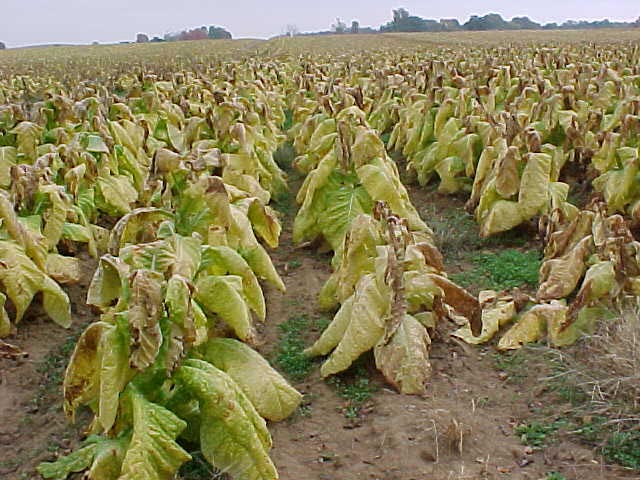PLANT & SOIL SCIENCES FACT SHEET TOB-4-06
![]()
Minimizing the Effects of Frost Damage in Tobacco
By Gary Palmer
Labor issues and early cold spells can result in tobacco crops that are exposed when the first frost occurs in the fall in Kentucky. Even when temperatures get close to developing frost, low lying areas may be vulnerable. While frost is never good for tobacco, it doesnít have to be devastating. The degree of damage depends on the extent and duration of the frost, whether the tobacco is cut or still standing and the amount of sunshine on following days.
While a mild frost may be inconsequential, a hard freeze may damage tobacco beyond recovery. However, a hard freeze is uncommon while tobacco is still in the field. Frost predicted for more than one day in a row may limit a producerís options.
Tobacco is most vulnerable when it has been freshly cut. Standing tobacco may be damaged by frost, but the chances for a good outcome are more likely. Therefore, avoid cutting when frost is predicted and expend labor to house cut tobacco rather than cutting more tobacco when frost is predicted. Tobacco that has been cut for several days and is fully wilted will still be damaged, but chances of the damaged tobacco curing green are reduced. Damaged leaves tend to cure darker, but the color may be undesirable.
The key to recovery from frost is sunshine. Just like sunburn, frost causes cell rupture and intercellular bleeding of chlorophyll. The chlorophyll can result in green color in the cured leaf or at least undesirable colors. Allowing sunlight to degrade the chlorophyll will reduce the chances of a green cure and improve overall quality. Two to three days of sunlight is usually sufficient to remove some of the damage and improve the cure.
In the past some growers chose to use available labor to pile cut sticks to minimize exposure. Using labor to load the tobacco on a wagon would be a more efficient and productive. However, tobacco will heat if allowed to sit on the wagon for more than about twelve hours. Heating is less likely with cooler temperatures, but even cold mornings may warm up to unsafe levels during the day. Load only as much tobacco as can be safely hung the following day. Other tobacco can be piled to minimize exposure.

Frost Damage Tobacco
In tests at the University of Kentucky, standing tobacco that had been severely frost damaged was allowed to stand another three days before cutting. The tobacco was damaged to the extent that leaves were severely drooping and the color had changed to an olive brown. After cutting the tobacco was housed normally, no appreciable leaf loss beyond normal was noted, and the tobacco was allowed to cure normally. The tobacco was evaluated at the end of curing and compared to tobacco housed prior to frost damage. No noticeable differences were found and anyone not knowing the history of this tobacco would have been unable to guess that it had been damaged by frost while in the field.
Early frost a few years ago confirmed these results. Tobacco that was left standing faired the best. However, a few areas in the northeastern part of the state dropped to freezing temperatures that damaged fresh cut tobacco and standing tobacco. Under those conditions freshly housed tobacco was not safe from the freezing temperatures and tobacco in some barns was severely damaged. These kinds of conditions are extremely rare in Kentucky when tobacco is still vulnerable.
Recap:
1. House freshly cut tobacco first.
2. Do not cut tobacco prior to a frost if unable to house
3. Allow sunlight to remove damage for approximately three days prior to cutting or housing frost damaged tobacco
![]()
![]()